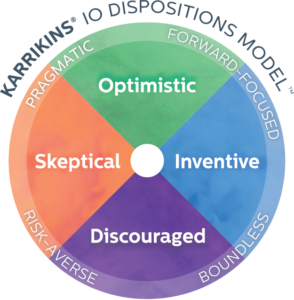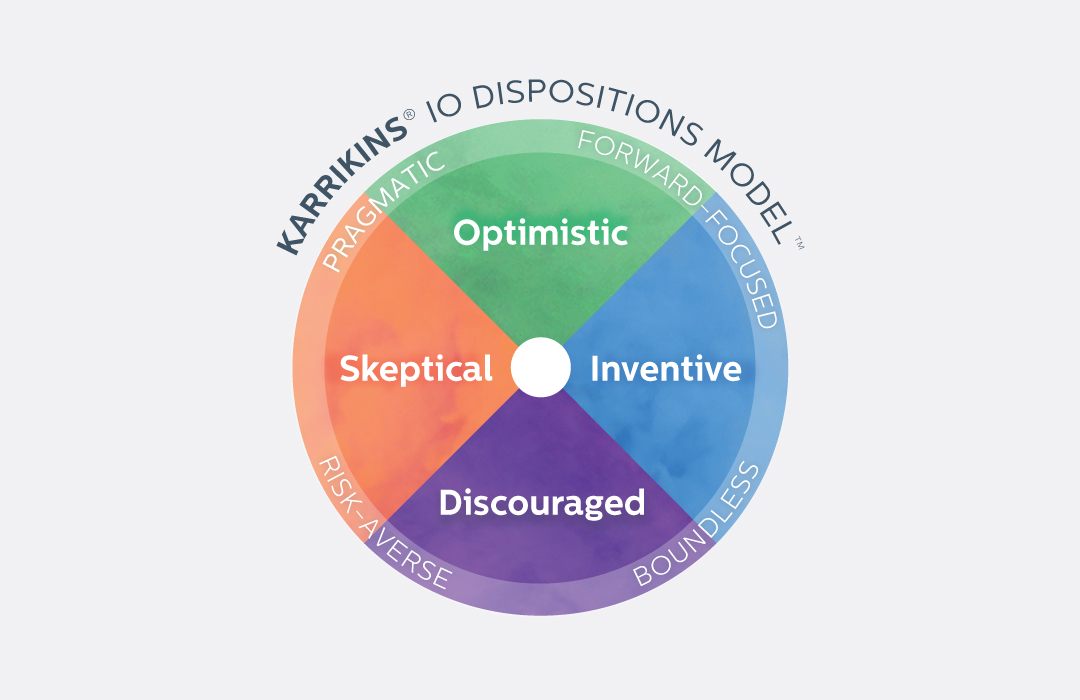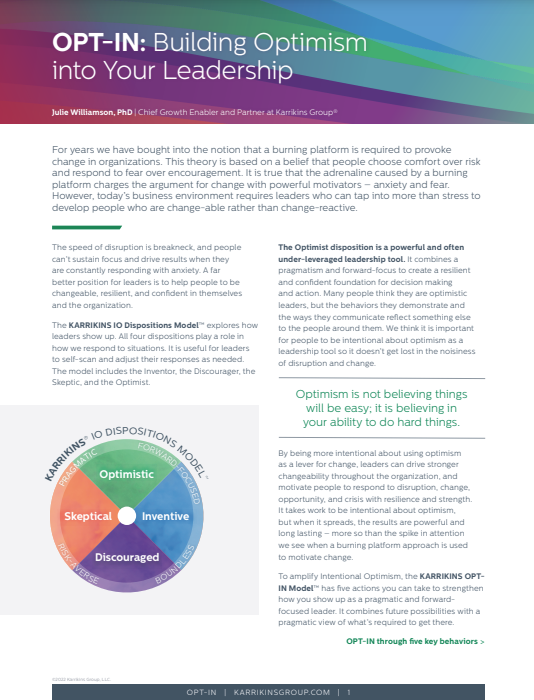Building Intentional Optimism Into Your Leadership
Optimism supercharges growth, connection, and success
Do you ever wonder what makes the difference between people who do extraordinary things and people who don’t? One key difference is optimism. The ability to see a positive future while pragmatically dealing with the realities of today gives people the motivation to respond to disruption, opportunity, and change with resilience and strength.
Download our free resource, OPT-IN: Building Optimism Into Your Leadership.
Table of Contents
Articles, White Papers, and Resources on Intentional Optimism
Check out our articles, white papers, and interactive resources with more in-depth conversations to help leaders cultivate Intentional Optimism.
No Results Found
The page you requested could not be found. Try refining your search, or use the navigation above to locate the post.
Video Resources on Intentional Optimism
Check out our thoughts on how Intentional Optimism can positively impact your leadership.
No Results Found
The page you requested could not be found. Try refining your search, or use the navigation above to locate the post.

The Dilemma of Delusion
Below is a preview from the book, OPT-IN: How Intentional Optimism Can Change Everything, by Julie Williamson, PhD:
Here’s what intentional optimism isn’t. It isn’t delusional.
Optimism isn’t believing that positive thinking will turn you into something you are not. I can sit and think positive thoughts all day long and I’m not going to become an Olympic caliber marathon runner, an astronaut, or a cat lover. I won’t be able to guarantee beautiful weather for my family’s one week of vacation next year or predict the winning lottery numbers. Being optimistic doesn’t mean I believe in magic.
Optimism is finding the confidence to step into something that is potentially hard, messy, and unpredictable and believing that you can make something amazing happen. It is being unafraid of a future that looks different from today because you are confident in your ability to learn, grow, and change personally and professionally. And, it is combining that confidence with a healthy dose of pragmatism about the work that is required.
Of the four dispositions we work with through our KARRIKINS IO Dispositions Model™, Inventors are the most likely to bump up against delusion. Interestingly, Skeptics can fall into the same trap – they can be flat out delusional in their belief that things will absolutely go wrong. They invent all sorts of reasons why the world is against them, or why something won’t work. In either direction, positive or negative, delusion is an extreme that doesn’t serve anyone well.
At the end of the day, delusion is asking yourself, What do I want? and then sitting around hoping it comes your way. Maybe even hoping REALLY HARD that it comes your way. And then wondering why it doesn’t.
Optimism is saying, I’m willing to work hard and take some risks to achieve that and then going out and putting in the time and effort, doing your best as challenges come up – knowing that best efforts sometimes fail and you are strong enough to survive failure and pick yourself back up again and move forward. It is what gives you the confidence to take risks and continue to learn and grow.

Why is Intentional Optimism Important in Leadership?
For years we have bought into the notion that a burning platform is required to provoke change in organizations. This theory is based on a belief that people choose comfort over risk and respond to fear over encouragement. It is true that the adrenaline caused by a burning platform charges the argument for change with powerful motivators – anxiety and fear.
However, today’s business environment requires leaders who can tap into more than stress to develop people who are change-able rather than change-reactive.
The speed of disruption is breakneck, and people can’t sustain focus and drive results when they are constantly responding with anxiety. A far better position for leaders is to help people to be changeable, resilient, and confident in themselves and the organization.
Optimism is not believing things will be easy; it is believing in your ability to do hard things.
By being more intentional about using optimism as a lever for change, leaders can drive stronger changeability throughout the organization, and motivate people to respond to disruption, change, opportunity, and crisis with resilience and strength. It takes work to be intentional about optimism, but when it spreads, the results are powerful and long lasting – more so than the spike in attention we see when a burning platform approach is used to motivate change.

5 Ways to Build Intentional Optimism in Your Leadership
To amplify Intentional Optimism, the KARRIKINS OPT-IN model™ has five actions you can take to strengthen how you show up as a pragmatic and forward-focused leader. It combines future possibilities with a pragmatic view of what’s required to get there.
Orient toward the best likely outcome.
Figure out what you can control and where you can have an impact, and decide what you will do in that space to create a positive outcome. It is important to remember that best and likely don’t always equal awesome. If you are skidding on black ice toward a concrete barrier, the best likely outcome might be that you mitigate harm by making whatever adjustments to speed and direction before the inevitable impact. Optimism isn’t about ignoring reality, it is about finding the place, no matter how small, where you have control and working there to make a difference.
Pursue forward-focused questions.
Ask questions that accelerate you toward the future by helping you to make progress while also course correcting as you go. Optimists ask questions and push into what is possible while also pragmatically investigating what is required to get there.
Take on the hard work.
Don’t bother being optimistic if you aren’t willing to work at something. Believing that something bold will be easy isn’t optimism – it is delusion. Own how you show up and do the hard work to have the impact you want to make. You might have to change yourself first, which is the hardest work of all. Figure out what is getting in your way. Do what is hard to break through – ask for help, give up comfort, take a risk. Optimism is not believing things will be easy; it is believing in your ability to do hard things.
Include unexpected others.
Does your organization use the same SMEs to solve every problem? Optimists have confidence in the ability of others to contribute in unexpected ways and to grow into SMEs by being included when it really matters. Take a chance by bringing in someone unexpected to problem solve or ideate. Optimists also know the value of the Skeptic and the Inventor – being the bridge between the two creates exciting new possibilities. Plus, it is way more fun!
Notice and name your choices.
One of the most powerful ways to tap into your inner Optimist is to notice and name your choices. Being intentional about what you are doing by paying attention and giving voice to it helps you to build your internal response systems and gives you a sense of control over what is happening around you. At the same time, it makes your choices more visible to others and helps spread optimism to the rest of your team.

Discover Your Leadership Disposition

The KARRIKINS IO Dispositions Model™ explores how leaders show up. All four dispositions play a role in how we respond to situations. It is useful for leaders to self-scan and adjust their responses as needed. The model includes the Inventor, the Discourager, the Skeptic, and the Optimist.
Want to learn more about Intentional Optimism and discover what your disposition might be and the impact it may have on your organization? Try the brief Intentional Optimism Dispositions Self-Scan and then go deeper with our coffee break on Infectious Leadership and the Intentional Optimism Dispositions.

Why Intentionally Optimistic Leaders Are Successful
According to our founder Peter Sheahan and current Karrikins Group Partner and Chief Growth Enabler Julie Williamson, PhD, research shows that whether they’ve started world-changing companies or turned failing organizations around, leaders who help their companies succeed share five powerful characteristics.
The first powerful characteristic optimistic leaders have in common?
They choose optimism.
Believing in a bright future for your company sends a powerful message to people who work in the organization. When leaders shine a light on what is possible, people are more likely to put in the hard work that transforms a promising vision into reality.
Below is a preview from the book, OPT-IN: How Intentional Optimism Can Change Everything, by Julie Williamson, PhD:
Optimism is the most powerful tool a leader has. It is also a hard skill to master. To lead from intentional optimism, you must pay close attention to the energy and language you are bringing into the space. You have to be willing to do the hard work of finding even small things you can control, and ways of seeing possibilities in the disruption happening around you. You have to bring enthusiasm, energy, and a positive mindset while also being honest, pragmatic, and well-informed.
Optimists see disruption and move from agreement to alignment. They don’t let perfect get in the way of progress. And they bring others along with them. They have the confidence to place themselves in a disrupted future and see potential instead of persecution.
Optimism is a choice we make through the questions we ask.

Intentional Optimism Drives Smart Risk
2015 was a year of big companies taking big risks. CVS quit selling cigarettes and walked away from ~$2B in reliable annual revenue. REI closed on Black Friday, telling customers to “opt-outside” on the biggest retail sales day of the year. Adobe finalized a transformation that had begun in 2012, moving fully away from well-understood cycles of product sales in big box operations to digital subscription models for its most valued customer base – designers and creatives. Years later, these companies continue to profit from what were at the time seen as potentially dangerous strategies. In each situation, the leadership teams had to make a decision to step away from reliable, predictable results and into the unknown.
These kinds of bold decisions come with built-in risks to the company’s brand, finances, and customer experience. And for public companies, perhaps the biggest risk is a very, very angry group of shareholders. When is it worth taking those risks? For some leaders, waiting until there is a burning platform is the answer. But there’s really no courage in jumping into action when everything is crashing around you – that’s just survival. We’d rather see leaders take a leap when things are reasonably fine. That’s when it really takes courage to choose a different path.
The courage to take on this kind of risk is fueled by optimism – a firm belief about what is possible in the future combined with a pragmatic assessment of today’s realities.
At Karrikins Group we believe in the power of intentional optimism to inspire people to take on the risk of going from just fine to amazing, and bringing others along with them (even the angriest of shareholders.)
Learn How to Lead With Intentional Optimism
Contact us to schedule a 30-minute consultation about how optimism can transform your leadership and your organization.

It takes an optimistic leader to counter the negativity bias and build change-able teams who collectively are willing to struggle through the hard work of exploring, growing, and experimenting with new ways of working to deliver different outcomes.
We see optimism as a superpower, and that’s why it is a core part of our Aligned Leader Program™. In ALP we talk about the importance of intentional optimism – cultivating your voice and energy as a leader in ways that spread confidence, risk tolerance, and exploration.
Related Content

Leading through challenge: Know where you are on the KARRIKINS Challenge Curve™

Intentional Optimism Dispositions Self-Scan



